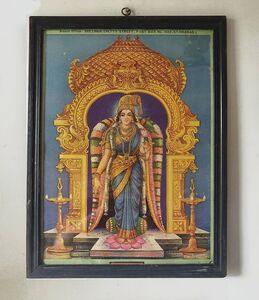
In the Hindu Pantheon of Gods, there is a Goddess who is a Poet. Kothai known as Goddess Andal is credited with the great Tamil Poetic works, Thiruppavai and Nachiar Tirumozhi.
Today, the Poet Goddess Andal is celebrated. She has a grand and famous temple at Srivilliputtur, south of Madurai, where she is worshipped with great love and adoration. Her poems form the backbone of this love, lacing stories and ceremonies of all who visit her there. There is no greater way for us to honour this great poet than to sit with her gorgeous, moving verses and to take her invitation to live within the world of the imagination she embroidered with words with such care and wonder.
Despite its continuous literary history, Tamil counts few female authors and poets prior to the twentieth century. Of these, the 9th-century poet, Kothai, is perhaps the most well-known among premodern female authors. Kothai is revered as Goddess Andal. We know little of her historical life, except for what we can glean from two magnificent poems – Tiruppavai, Sacred Vow, and Nacciyar Tirumoli, A Woman’s Sacred Utterance, – that have come down to us. The two masterful compositions explore committed, ecstatic devotion to Lord Vishnu.
Kothai’s shaping of female voices and female spaces is unparalleled. In the short Tiruppavai, a poem of 30 verses, Kothai describes a vow undertaken by young girls to win a husband for themselves. As this is a bhakti poem, the desired for husband is none other than Krishna. While the commentarial and hagiographical tradition reads the poem autobiographically, that is, the poet performing the vow herself, Kothai explicitly declares that she has imagined the scenario, saying so in the poem’s concluding phala shruti verse: “Kothai sang of cowherd women”. Thus, in the Tiruppavai, we hear Kothai speak in the voice of not one or two, but several Gopis, cowherd girls awakening in the pre-dawn hours, to cleanse themselves and to arrive at Krishna’s door to pray to him for his love.
Although Krishna is at the centre of this poem, it is a woman’s world he inhabits. We hear the churning of butter, the milking of cows, women adorning themselves in jewels, calling to each other, urging mothers and aunts to help them in their joint quest. Indeed, in one of the most famous verses, the girls address Nappinnai, Krishna’s wife, asking her to intercede on their behalf.
If the Tiruppavai is largely univocal, all the plural Gopi-voices collapsing into one, the longer Nacciyar Tirumoli which consists of 143 verses spread over 14 sections is more complex. Like the Tiruppavai, it too begins with a vow, except this one is undertaken by a single person, a woman, whom the poet clearly identifies as herself. But this early invitation to read the Nacciyar Tirumoli as autobiographical gives way to the emergence of our Gopi girls from the Tiruppavai, who appear in Nacciyar Tirumoli 2 and abruptly disappear in Nacciyar Tirumoli 5.
Andal is one of the best-loved poet-godess of the Tamils. Pious tradition holds her to be the incarnation of Bhūmi Devi (Sri Lakshmi as Mother Earth) to show humanity the way to Lord Vishnu's lotus feet. Representations of her next to Vishnu are present in all vaishnava temples. During the month of Margazhi, discourses on the Thiruppavai in Tamil, Telugu, Kannada, and Hindi take place all over India. The Srivilliputhur Divya Desam at Srivilliputhur consists of twin temples, one of which is dedicated to Andal. Most South Indian Vishnu temples have a separate shrine for Andal. There are a number of festivals dedicated to Andal, among the most notable being the Pavai Nonbu in the Tamil month of Margazhi, Andal Thirukalyanam in Panguni, Pagalpathu, Rapathu, Adi Thiruvizha, when Andal is depicted seated in the lap of Ranganathar. Ranganathar is a Hindu deity, more well known in South India. The deity is a resting form of Lord Vishnu, recumbent on the great form of the serpent god Adisesha, one of the foremost of Hindu gods. Andal is known for her unwavering devotion to Lord Vishnu, the God of the Gods.
